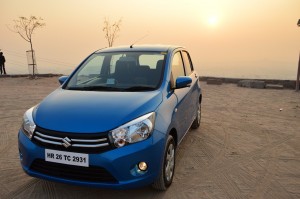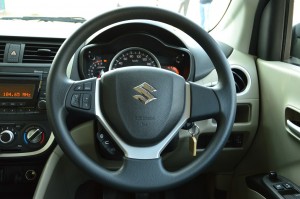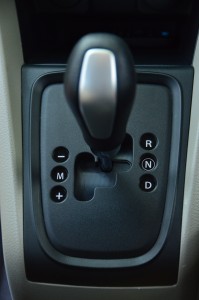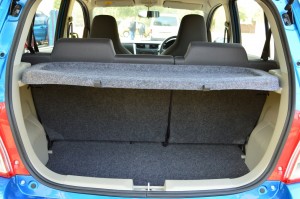Srikant J
Once every few years there comes a vehicle that challenges the set perceptions of the public about a particular segment of cars. The iconic M800 started it in the mid-80s; Toyota Qualis did it for MUVs and Mahindra Scorpio did so for the SUV segment. Maruti Suzuki now banks on the Celerio, with its much acclaimed first-in-the-country Automated Manual Transmission (AMT), to do the same for hatchbacks in India. While it has the convenience of an automatic, it costs almost the same as the manual transmission, with similar fuel efficiency and reduced emissions. Maruti has claimed a fuel efficiency of 23.1kmpl for both the manual and AMT versions. These attributes made the customers prefer the AMT, which is evident from the sales outnumbering the manual transmission model.
 We got to test drive the Celerio AMT version during peak office hours in Delhi. The heavy traffic during the rush hour, gave us the perfect stop-and-go run to test the performance of the AMT. The first impression was good. We made sure that we drove for the maximum time on the auto mode because we believe that this is the mode in which it will be driven the longest during its lifetime. From a driver’s perspective, operating the AMT in auto mode is similar to any other automatic. Slot the gear into neutral, start the engine with the brake pressed and shift the gear into ‘Drive’ (D), then let go of the brake. The car eases into a 5 kmph cruise without the accelerator depressed – this is called the creep function. The creep didn’t feel too strong – say compared to the A-star AT; the driver might have to open the throttle a bit if the car is on a slope, depending on the gradient.
We got to test drive the Celerio AMT version during peak office hours in Delhi. The heavy traffic during the rush hour, gave us the perfect stop-and-go run to test the performance of the AMT. The first impression was good. We made sure that we drove for the maximum time on the auto mode because we believe that this is the mode in which it will be driven the longest during its lifetime. From a driver’s perspective, operating the AMT in auto mode is similar to any other automatic. Slot the gear into neutral, start the engine with the brake pressed and shift the gear into ‘Drive’ (D), then let go of the brake. The car eases into a 5 kmph cruise without the accelerator depressed – this is called the creep function. The creep didn’t feel too strong – say compared to the A-star AT; the driver might have to open the throttle a bit if the car is on a slope, depending on the gradient.
Although you did get to know when up-shifts were happening, thanks to the long pause between two gears, it was smooth enough to keep the ride jerk-free. Unlike, regular automatics, there is no ’Park’ mode in this automated transmission. You will have to make do with the parking brake instead.
 How is the AMT different from the regular automatic or the manual transmission? The answer: not very much. Christened ‘Auto Gear Shifter’, it falls somewhere between the two modes. It is primarily a manual transmission with an electro-hydraulic system that scientifically shift gears for the driver. This system, which can be coupled with any manual transmission, performs the opening and closing of the clutch. Both these movements are executed by hydraulic actuators which in turn are controlled by the Transmission Control Unit (TCU), thus doing away the need for a manual clutch.
How is the AMT different from the regular automatic or the manual transmission? The answer: not very much. Christened ‘Auto Gear Shifter’, it falls somewhere between the two modes. It is primarily a manual transmission with an electro-hydraulic system that scientifically shift gears for the driver. This system, which can be coupled with any manual transmission, performs the opening and closing of the clutch. Both these movements are executed by hydraulic actuators which in turn are controlled by the Transmission Control Unit (TCU), thus doing away the need for a manual clutch.
The manual transmission is controlled by a set of cables or a link, following dual movements – linear and horizontal. This means, select the gear position and engage. In the AMT, the shifting process is performed by an actuator that is mounted on the gearbox itself. The actuator is controlled by the TCU, which gets signals from different locations including the engine. Similarly, the clutch is also electronically actuated based on the signal that it gets from the control unit. However, it does not take away driving pleasure as a manual option is given.
With their optimised shift points, AMTs also help reduce torque interruption to a minimum between shifts. As an array of sensors register and convey all key information through a transmission control module, the system can automatically adjust shift points and control the clutch according to driver based inputs. The AMT’s ECU can also intervene to improve safety by automatically interrupting drive flow to counter the risk of skidding if the vehicle loses traction.
The main advantage for the OEMs is the cost – primarily due to standardisation of transmission, unlike the automatics that call for a totally different unit, which is heavier and voluminous – eventually consuming more space and escalating costs significantly. Overall, AMT enhances life of clutch components while cutting down on emissions and improving economy.
 The performance too was satisfactory with power being uniformly distributed across the rev-band. The car uses, what Maruti calls, the K-Next engine. The 1-litre, 3-cylinder engine produces 67bhp @ 6000 rpm and a torque of 90 Nm @ 3500. The K-next engine is the upgraded version of the K-series engine used in most of Maruti Suzuki’s hatchbacks like Alto K10, WagonR and Swift. “K Next Engine, which uses drive-by-wire technology, has been developed with due consideration of the automatic transmission. Apart from the hardware like Electronic Throttle Body, the Engine Controller logic takes a major change to support this transmission,” said CV Raman, Executive Director (Engineering) Maruti Suzuki India Limited.
The performance too was satisfactory with power being uniformly distributed across the rev-band. The car uses, what Maruti calls, the K-Next engine. The 1-litre, 3-cylinder engine produces 67bhp @ 6000 rpm and a torque of 90 Nm @ 3500. The K-next engine is the upgraded version of the K-series engine used in most of Maruti Suzuki’s hatchbacks like Alto K10, WagonR and Swift. “K Next Engine, which uses drive-by-wire technology, has been developed with due consideration of the automatic transmission. Apart from the hardware like Electronic Throttle Body, the Engine Controller logic takes a major change to support this transmission,” said CV Raman, Executive Director (Engineering) Maruti Suzuki India Limited.
Shift into manual mode and the performance gets a solid boost. The throttle response becomes much better making overtaking a lot easier. But push it a bit harder and the NVH levels start playing spoilsport. The 3-cylinder engine became noticeably loud and even vibrations made their presence felt.
But the Celerio does not have the road-presence that its maker would have liked it to have. In fact, it will not be off the mark to say it looks much like the grown-up Alto 800 with a hint of A-star in it. It is not the most extrovert design to come out of Maruti Suzuki’s stable but it does have some nice touches. It employs what Maruti calls a curve-in-curve-out design enhancing its muscular look by giving it strong shoulder lines, at the same time improving aerodynamics.
The front grill with two chrome plated lines was first seen in the Suzuki concept A: Wind concept, which was unveiled at the 30th Thailand International Motor Expo 2013. Although, in Celerio, the chrome lines do not merge into the headlamps à la the A: Wind, the somewhat identical styling, along with swept-back headlamps does give the front a contemporary look, if not the A: Wind’s futuristic touch. The Celerio runs on 155/60 R13 tyres in Lxi trim whereas Vxi and Zxi trims run on 165/70 R14. There are also 7 refreshing colours to choose from: Blazing Red, Sunshine Ray, Cerulean Blue, Silky Silver, Glistening Grey, Cave Black and Pearl Arctic White.
The Celerio is built on a new platform that incorporates numerous value additions to make the car more practical. From the interior design point of view, the car uses something called an Xpan design. This design gives a higher level of flexibility to the back seats, allowing more space inside, giving the cabin a spacious feel. Apart from the Lxi version, all versions get 60:40 rear split seats. This also improves the boot space which is a decent 235 litres with rear seats up. The company was also able to pack-in loads of utility spaces – 15 in all, for both front and rear passengers. The gear shifter has been placed on the dashboard with enough space between the stick and the handbrake to squeeze in two cup holders. The dual tone colours have also been smartly appointed with black plastic being used in all the areas which are expected to be tinkered with regularly.
 Even features wise, there are many neat additions to spice up the oomph factor of this newest hatchback from India’s largest car maker. While the AMT variants do come with some exclusive bells and whistles – like the gear indicator and outside temperature display, the AMT is not provided in the top-most ZXI trim. This robs AMT buyers of some key features like front airbags, ABS, tilt steering, alloy wheels, keyless entry and steering-mounted audio controls and Bluetooth connectivity. The quality of interior plastics is decent enough to give you the feel of a car a segment higher. You also do see a bit of Ritz’s u-shaped central console and Swift’s waterfall dashboard design in Celerio, indicative of which family it belongs to.
Even features wise, there are many neat additions to spice up the oomph factor of this newest hatchback from India’s largest car maker. While the AMT variants do come with some exclusive bells and whistles – like the gear indicator and outside temperature display, the AMT is not provided in the top-most ZXI trim. This robs AMT buyers of some key features like front airbags, ABS, tilt steering, alloy wheels, keyless entry and steering-mounted audio controls and Bluetooth connectivity. The quality of interior plastics is decent enough to give you the feel of a car a segment higher. You also do see a bit of Ritz’s u-shaped central console and Swift’s waterfall dashboard design in Celerio, indicative of which family it belongs to.
 Expectedly, the addition of extra components to the transmission has led to an increase in weight. However, in order not to lose the advantage it gained from AMT because of higher gross weight, Maruti Suzuki has worked on other aspects to keep the overall weight of the car under check. The Celerio has made extensive use of high tensile steel and also used lighter alternative material like polymers in the fuel tank and intake manifold. “We made use of virtual engineering techniques to reduce weight during engineering concept rendering,” said Raman. The end product weighs an impressive 830kg, which is far less than the competition, and is nearly 100kg lighter than the Hyundai Grand i10, Chevrolet Beat and Honda Brio.
Expectedly, the addition of extra components to the transmission has led to an increase in weight. However, in order not to lose the advantage it gained from AMT because of higher gross weight, Maruti Suzuki has worked on other aspects to keep the overall weight of the car under check. The Celerio has made extensive use of high tensile steel and also used lighter alternative material like polymers in the fuel tank and intake manifold. “We made use of virtual engineering techniques to reduce weight during engineering concept rendering,” said Raman. The end product weighs an impressive 830kg, which is far less than the competition, and is nearly 100kg lighter than the Hyundai Grand i10, Chevrolet Beat and Honda Brio.
While the light-weight works well for the economy of the car, it does have a slight negative impact on the handling. If you hit a sudden dip in the road at speeds around 70kmph or above, the car seems to float in air for a while giving that unnerving sensation to the driver. We also felt the steering to be a little too light for our liking. No doubt, it makes city driving a breeze, which is what the car is made for – city trotting. But high speed dynamics are compromised a bit, and out on the highway the driver might feel a little less confident.
Raman said that the challenges in development of any product are compounded when it is intended to revolutionise the market space and chief among them was to correctly predict the requirements of the customer at the time of conceptualisation, which is years before the product launch. “Engineering phase involved ensuring that at every quality gate when we verified the product against the concept, it had to surpass the targets we had set for the team. Of course, being a new technology, the challenge to ensure reliability of the product in the field involved extensive evaluation.”
Overall, the Celerio with AMT is a practical car for most Indian cities, where bumper-to-bumper cruising has become synonymous with driving. And with similar pricing, the automatic version, if we take the liberty of calling the AMT version that, for the first time is expected to do better sales than the manual version. The base model of AMT starts at Rs 4.29 lakh, just Rs 39,000 over the manual base model.












One Comment